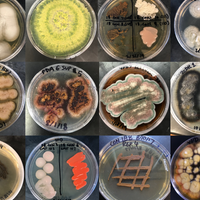cell division

Downsizing DNA
Aparna Nathan, PhD | Dec 4, 2023 | 10 min read
Some species remove up to 90 percent of their genomes during development, but why or how this happens is still a mystery.

Infographic: Programmed DNA Elimination
Aparna Nathan, PhD | Dec 4, 2023 | 3 min read
Removing parts of the genome is a key step in some species’ development.

“Cryptic Transcription”: How Aging Cells Express Fragments of Genes
Kamal Nahas, PhD | Apr 6, 2023 | 4 min read
Aging cells with weakened gene regulation spuriously transcribe RNAs, but their impact on health and longevity still needs to be examined.

How Tadpoles Garner the Energy to Regenerate Their Tails
Natalia Mesa, PhD | Mar 1, 2023 | 3 min read
A metabolic pathway used for tail regrowth may be critical for tissue regeneration in some cells, a study suggests.

Infographic: How Tadpoles Use Glucose to Fuel Tail Regrowth
Natalia Mesa, PhD | Mar 1, 2023 | 1 min read
Unlike other fast-growing cells, regenerating tadpole cells fuel growth using the pentose phosphate pathway rather than glycolysis, a study indicates.

How a Bacterium Manages to Reproduce During Famine
Viviane Callier | Jul 18, 2022 | 3 min read
When Caulobacter crescentus finds itself in a nutrient-poor environment, it clusters an enzyme necessary for cell division thanks to a physical phenomenon known as phase separation so it can make better use of dwindling fuel.

Infographic: Nutrient Scarcity Drives Phase Separation in Bacteria
Viviane Callier | Jul 18, 2022 | 1 min read
When the bacterium Caulobacter crescentus runs low on fuel, it can still replicate by clustering its remaining ATP around the cell division enzyme DivJ.

Science Snapshot: Mitotic Housekeeping
Lisa Winter | May 11, 2022 | 1 min read
Researchers reveal that a measurable drop in the dry mass of a cell prior to mitosis is caused by waste products being jettisoned before the cell divides.

Bridging Disciplines to Study CRISPR-Induced Chromosome Destabilization
Aparna Nathan, PhD | Apr 8, 2022 | 4 min read
A collaboration between friends led to a cautionary finding about CRISPR’s effect on cells.

How Chaos in Chromosomes Helps Drive Cancer Spread
Samuel F. Bakhoum | Mar 1, 2022 | 10+ min read
A new link between inflammation and rampant chromosomal abnormalities reveals novel strategies to treat diverse malignancies.

Infographic: Chromosome Errors Cause Micronuclei and Drive Cancer
Samuel F. Bakhoum | Mar 1, 2022 | 2 min read
When micronuclei rupture, chromosomes break, recombine, and form circles, causing inflammation and promoting carcinogenic growth.

The Scientist Speaks - DIY Cells: Understanding Life with a Synthetic Minimal Cell
Sejal Davla, PhD | Feb 25, 2022 | 1 min read
John Glass describes why researchers constructed a synthetic unicellular organism and how it unravels the secrets of evolution.

The Scientist Speaks - The Reality of Regenerative Medicine
The Scientist | Aug 26, 2021 | 1 min read
After decades of research the potential of regenerative medicine becomes a life-saving reality.

Stress-Induced Chromosome Changes Protect Flies’ Aging Brains
Lisa Winter | Dec 1, 2020 | 2 min read
Brain cells in older Drosophila tend to have more than two complete sets of chromosomes, and that polyploidy most likely has a protective function, a study shows.

Image of the Day: Scrambled Frog Eggs
Emily Makowski | Nov 6, 2019 | 2 min read
Cellular innards can reorganize themselves to form structures similar to cells.

Image of the Day: Unusual Fungi Reproduction
Emily Makowski | Oct 30, 2019 | 2 min read
A variety of yeasts collected near Woods Hole, Massachusetts, show unconventional cell division.

Microscopy and Imaging Leader Shinya Inoué Dies
Jef Akst | Oct 7, 2019 | 1 min read
The long-time Marine Biological Laboratory scientist was known for using his own hand-built microscopes to image the dynamics of live cells.

Image of the Day: Mother Machine
Emily Makowski | Sep 20, 2019 | 1 min read
Bacteria grow and divide in microfluidic channels.

Image of the Day: Wrench in the Works
Carolyn Wilke | Mar 26, 2019 | 1 min read
In cell division, a protein called spastin appears to help tear down a bridge between daughter cells.
